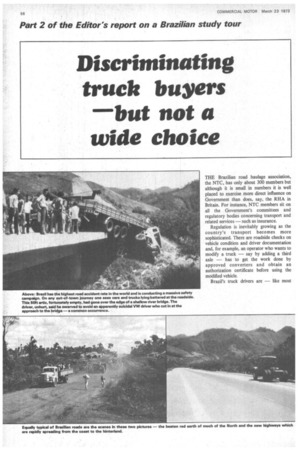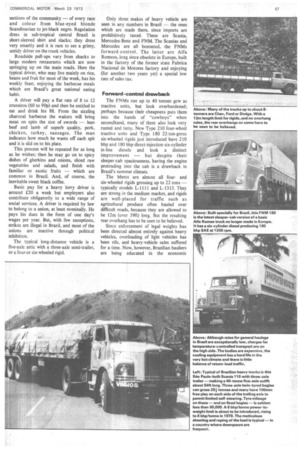Discriminating truck buyers but not a wide choice
Page 54

Page 55

Page 56

If you've noticed an error in this article please click here to report it so we can fix it.
THE Brazilian road haulage association, the NTC, has only about 300 members but although it is small in numbers it is well placed to exercise more direct influence on Government than does, say, the RHA in Britain. For instance, NTC members sit on all the Government's committees and regulatory bodies concerning transport and related services — such as insurance.
Regulation is inevitably growing as the country's transport becomes more sophisticated. There are roadside checks on vehicle condition and driver documentation and, for example, an operator who wants to modify a truck — say by adding a third axle — has to get the work done by approved converters and obtain an authorization certificate before using the modified vehicle.
Brazil's truck drivers are — like most sections of the community — of every race and colour from blue-eyed blonde Scandinavian to jet-black negro. Regulation dress in sub-tropical central Brazil is short-sleeved shirt and slacks; they dress very smartly and it is rare to see a grimy, untidy driver on the trunk vehicles.
Roadside pull-ups vary from shacks to large modern restaurants which are now springing up on the main roads. Here the typical driver, who may live mainly on rice, beans and fruit for most of the week, has his weekly feast, enjoying the barbecue meals which are Brazil's great national eating habit.
A driver will pay a flat rate of 8 to 12 cruzeiros (60 to 90p) and then be entitled to eat and drink his fill. From the sizzling charcoal barbecue the waiters will bring meat on spits the size of swords — lean beef and lamb of superb quality, pork, chicken, turkey, sausages. The man indicates how much he wants off each spit and it is slid on to his plate.
This process will be repeated for as long as he wishes; then he may go on to spicy dishes of gherkins and onions, sliced raw vegetables and salads, and finish with familiar or exotic fruits — which are common in Brazil. And, of course, the inevitable sweet black coffee.
Basic pay for a heavy lorry driver is around £20 a week but employers also contribute obligatorily to a wide range of social services. A driver is required by law to belong to a union, at least nominally. He pays his dues in the form of one day's wages per year. But, with few exceptions, strikes are illegal in Brazil, and most of the unions are inactive through political The typical long-distance vehicle is a five-axle artic with a three-axle semi-trailer, or a four-or six-wheeled rigid. Only three makes of heavy vehicle are seen in any numbers in Brazil — the ones which are made there, since imports are prohibitively taxed. These are Scania, Mercedes-Benz and FNM. The Scanias and Mercedes are all bonneted, the FNMs forward-control. The latter are Alfa Romeos, long since obsolete in Europe, built in the factory of the former state Fabrica Nacional de Motores factory and enjoying (for another two years yet) a special low rate of sales tax.
Forward-control drawback
The FNMs run up to 40 tonnes gcw as tractive units, but look overburdened; perhaps because their cheapness puts them into the hands of "cowboys" when secondhand, many of them also look very rusted and tatty. New Type 210 four-wheel tractive units and Type 180 22-ton-gross six-wheeled rigids just introduced have 210 bhp and 180 bhp direct-injection six-cylinder in-line diesels and look a distinct improvement -but despite their sleeper-cab spaciousness, having the engine protruding into the cab is a drawback in Brazil's summer climate.
The Mercs are almost all fourand six-wheeled rigids grossing up to 22 tons — typically models L-1111 and L-1313. They are strong in the medium market, and rigids are well-placed for traffic such as agricultural produce often hauled over difficult roads, because they are allowed to be 12m (over 39ft) long. But the resulting rear overhang has to be seen to be believed.
Since enforcement of legal weights has been directed almost entirely against heavy vehicles, overloading of light vehicles has been rife, and heavy vehiclesales suffered for a time. Now, however, Brazilian hauliers are being educated in the economic advantages of heavier trucks — not least by the NTC through seminars and its excellent monthly journal, and Mercedes intends to re-enter the maximum-capacity market in Brazil.
Meanwhile the Scania Dll-engined bonneted, and mostly turbocharged, trucks and tractive units built at Sao Paulo are making big inroads into the heavy truck market. Over 1300 were sold last year, some 40 per cent of the heavy market, and there are 10,000 Scania trucks on Brazilian roads now.
Interestingly, the proportion sold with power steering has junfped from 10 per cent to 95 per cent in one year; hauliers had feared strong objections from the less fortunate drivers of the manual-steering trucks bat now they've taken the plunge they're encountering no problems. And in a country with the highest accident rate in the world, drivers need all the help they can get.
Choosy buyers
Although Brazilian haulage is in its infancy as an industry, operators are rapidly becoming very discriminating in their purchases. I was impressed by the readiness with which new equipment and ideas were taken up — even when they were quite costly — so long as a real return could be demonstrated. Truck specification is a typical area — they don't cheesepare on the basics or the extras. And makers have to live up to high standards. The chief test driver at Saab-Scania do Brasil's Sao Paulo factory told me that every vehicle off the line gets a rigorous 50km test run, as well as static tests, before delivery.
The light end of the truck market is filled by American designs — Ford, Chevrolet and Chrysler — and petrol engines are still used in many trucks up to 6 tons gvw. Perkins' Brazilian factory supplies the 133bhp diesel for many of the light and medium models, but now Cummins has bought the ex-Magirus bus and engine factory in Bahia there are suggestions that heavy US trucks will be built in Brazil. And at least one more European chassis maker has plans in this potentially lucrative market.
Not that building trucks in Brazil is easy. The local content has to be 98 per cent by weight; if components are imported they pay up to 150 per cent duty. But once a manufacturer sets out to meet the local content rules, and especially if he guarantees very high exports of the finished article, then. Brazilian law assures him of special treatment and considerable financial advantages.
British commercial vehicle makers left Brazil about 20 years ago, when the economic and political situation was very black. It would be nice to see British trucks — and buses — on Brazilian roads again.
And it's just the country for any aspiring British haulier who enjoys the zest of pioneering and thinks he could survive a repeat of the free-for-all Twenties on a vaster scale.












































































































